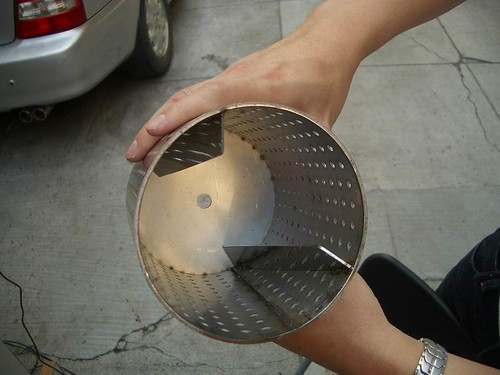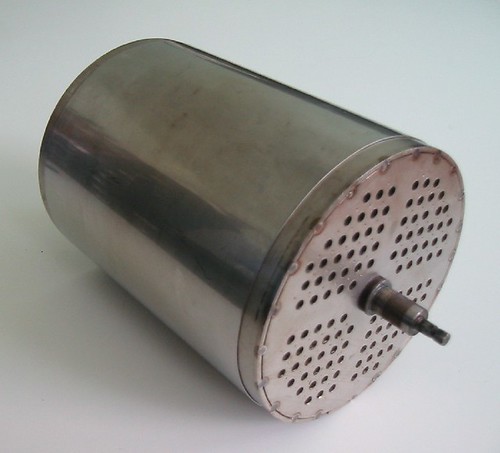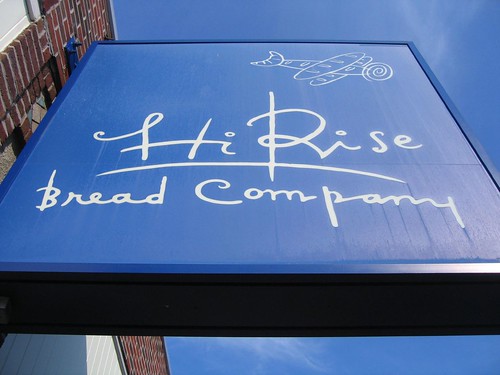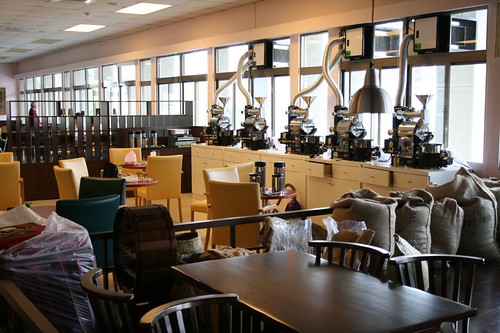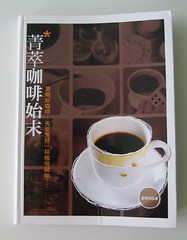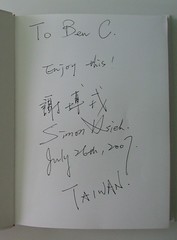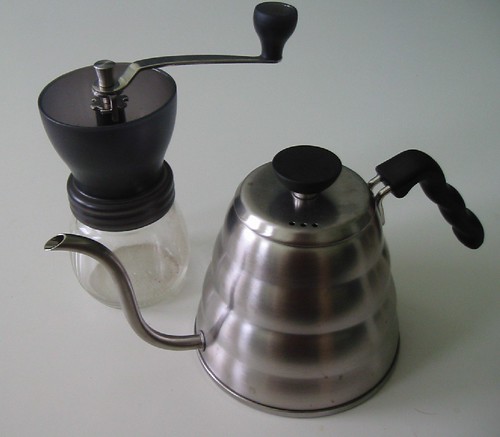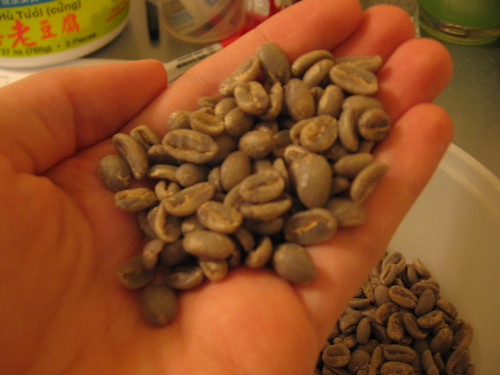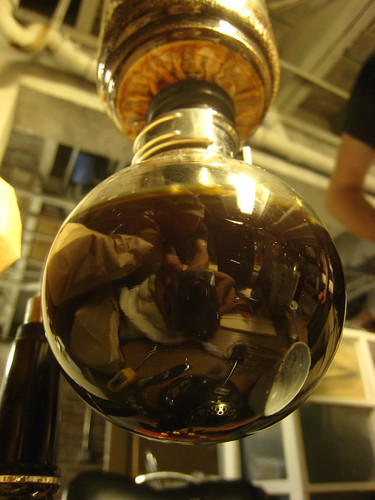Friday, December 21, 2007
It's all about volume
So let me add a few thoughts on volume and quality.
Volume begets buying power. Buying power allows for purchase of better product or quite simply, purchasing discounts. The problem therein, the best product is only available in limited supply and at a high cost so scale becomes relevant to access and purchasing power.
Building for volume then means you may have the buying power to get the best coffees but then you also may get too large in volume to offer them to all your accounts or too large in scale to focus on producing the product at near peak efficiency. It becomes a relevant question if the end quality even exists to justify the purchase of the high grade product at certain volumes. Once you begin a volume model, there must be a minimum and a maximum to sustaining peak quality but I feel like many roasting outfits pass the maximum threshold well before the machines are running at max capacity.
Think on this, the best lots are tiny, the best roasts are at less than full capacity, the best brews are often manual and labor intensive. The best product must then be quite manual, labor intensive, and time consuming at every step in production. It's everything a volume business is not. Though every sustainable model currently in coffee focuses on volume and still screams about quality during every step of the way, it seems that the roasting part of the coffee business and especially the cafe end are about as volume oriented as you can get.
A true specialty model would be built solely on the top end coffees and focusing on producing them at maximum quality. Does a roasting outfit like this exist and could it survive under the current market OR would it simply lack access to top green coffees for lack of buying power? Could they even get through all the convoluted 'fairly directly organicaly' traded speak out there to a market segment willing to pay top dollar for detailed execution of a good cup?
Many roasters who dabble in the most expensive green seem to be buying a lot of low grade coffees to fill out the majority of their offerings which they sell in volume to a multitude of cafe accounts. In many cases, the margin on a sub $2/lb coffee can be much larger than on one of these top placing CoE winners. The truth is that you can jack up the cheaper greens once roasted several times the actual production cost but the price multiplier on an expensive coffee leaves a slim margin. This is built on a fear that consumers won't pay the high prices. It almost seems that buying the top coffees are simply marketing schemes to attract high volume accounts with some 'credibility' so a company can then push the lower tier coffees at good margins.
At low margins, as established by the current market, how can a business focus on solely top end 'gold bag' product without selling a lot of 'black bag' offerings to shore up the financials? How do they keep the disconnect out of the public eye and balance a commitment to both ends of the business? How can you commit to quality and charge a profitable price AND still be able to buy top product in the current market at a smaller production volume?
Tuesday, December 11, 2007
Cambridge Coffee Notes
-I saw Nick Cho and Trish at Simon's. No idea if Simon is going to send people to the North East Regional Barista competition. It's in Ithaca NY which seems closer to Chicago than it is to us here in Cambridge. Simon's or Diesel really should send someone to compete but the reward vs cost is still mostly intangible for those who don't know if they could actually win some prize money. It's likely I won't even be in the country during the event anyway so I'm not making plans.
-A friend is about to take charge of the coffee program at a local cafe that promises to be the new hot spot for coffee in town. I wish I could say more but it looks like a fantastic fit for an old coffee place with a new direction. Details will follow when he is comfy breaking the news. Maybe we'll get him blogging about the changes as they happen!
-Simon Hsieh will be stateside for a week in January, we plan on having an event to discuss some of his ground breaking philosophies and taste a lot of great coffees. Expect some vac pot wizardry as he demos a syphon coffee bar...
-I spent a lot of time lately with Simon (the one in Cambridge) on his fetco(drip brewer) and adjusting his bulk grinder. The rewards have been immediate and have showed a better cup overall. The Costa Rica, La Minita from Atomic Cafe was coming out like maple syrup.
-Evidently our old buddy Nick Brown is working his coffee magic at Manic in Toronto. Kaminsky had a Rwanda Golden cup that was noteworthy in store. Shocking what a small community it is!
-Post tasting event, we had one roaster complain, one more open minded roaster ask for more events, and a cafe owner show interest in having more events. To that end, we are approaching a few cafes to have a local barista focused event. Not really sure about details or who would be interested but I'm asking around.
Saturday, December 08, 2007
Oh the humanity!
 Coffee shops are often a unique set of personalities and even in the cleanest most organized ones, there are still bits of drama.
Coffee shops are often a unique set of personalities and even in the cleanest most organized ones, there are still bits of drama.While we often tend to get self important as barista, the truth is that we are only the end in a long chain. Quality is every single step in the coffee production chain. As a barista, I can speak from a great deal of experiences, returned roasts, tense meetings, and general service of some embarrassing shots that the barista is often the fall guy as much as the occasional hero. The barista may, at times, be able to swoop in and bask in some of the glory but they are simply the last step in a hugely complicated process.
I'm not even going to get into all the details of production at the farm level. If anything, I really believe in focusing on the demand the rest of the chain sets rather than the supply. If we search out and pay for better sorting, cleaner prep, riper coffees, and more interesting high elevation 'sexy' varietals, farmers will respond.
The irony is that while many people see the complications in preserving quality, few people take the attitude that this is as absolute as it appears. Obviously, it becomes increasingly difficult financially at every step in the process but while many green buyers acknowledge that coffee tastes great at the gate they are hesitant to spend the money on measures to prevent fading and staling. There is even research and documentation at many levels detailing this which begs the question, who can really argue green doesn't age? Yet, many still pack coffees in jute bags in uncontrolled conditions such as large multi use warehouses with no intention of ever upgrading. Imagine having a warehouse deep in an area like Georgia where the heat and humidity turned your green from emerald jewels to tan lifeless wood in short order during the summer. Imagine that jute fiber flavor penetrating and contaminating your coffees while small bug bites and molds are spreading bit by bit with little bluish green spots as pales are appearing more and more over time. Hugging the farmer through the bean isn't so romantic anymore is it, especially if the green goes south?
Then you have the other situation where someone gets all that absolutely and spares no penny to expedite transport and store them, then preserve them with great labor including re-bagging the coffees. Then they roast them to death or worse, the roasts are all over the map with mind boggling inconsistency or dare I say it, simply mislabeled before shipment. Why should any of us pay for a product that's all over the map? What good is a 90pt coffee roasted a bit too dark or roasted light simply just for the sake of light? What good is it if the roast is just plain botched?
All that comes down to the barista, who assuming any small amount of that 90pt cup remains, they are left to try and figure it out. If they are extremely lucky, the equipment is somewhat clean and cared for while possibly up to date. They might even have some semblance of training or communication from the roaster to get something out of the coffee. If you, as a consumer are extremely lucky, all of it comes together and you get a decent cup worth paying for.
A friend asks, what part of the the process effects flavor the most? The real question is what will a 90pt cup taste like when at every step in the process, it actually came out the best it could? BTW his better half has a blog too where she often disagrees with him...
Monday, December 03, 2007
Espresso: The delay timer hack

photo originally uploaded by hazelsheard.
Simon's Coffee Shop has been working with a delay timer on the machine for the last few weeks. The basic setup involves a flow regulator and an adjustable delay timer that controls when the rotary pump kicks in.
The idea is that you use the flow regulator to control line pressure during a 'pre-infusion' where the pump does not kick in yet. To set it up, you adjust your line pressure to get your first drip at a desired time.
Let's say in this case, 5 seconds. Then you setup your timer to kick in at that same 5 second mark and your pstat will swing up to 9 bars at that point from your line pressure of say, 4 bars. This involves a lot of grind tweaking and adjustment during the early stages and graphing it would be weird so don't ask.
You then go through a series of adjustments testing from 3 seconds on up to 10 seconds to find the right balance for your espresso(assuming a fixed dose/extraction volume... at least temporarily). It helps to have an ideal batch of roasts lying around or work with it over a week or two instead of trying to coffee out and fix it in one night.
The original idea we had was that we could imitate the Synesso's style of pre-infusion where the pump kicks in at your manual control. Often overlooked on a Synesso, you can soak the puck with line pressure by moving the paddle to the middle position and then let pump pressure start when the paddle is moved to the full on position. The delay timer/flow regulator setup is meant to imitate this in an automated manner.
It's a hack. Don't get me wrong, I don't profess anyone should install this setup on their machine unless they know what they are getting into. For the price though, it gives you an almost lab style setup to make adjustments and we should credit whoever we originally took the idea from but I can't remember who we stole it from. Of course, a local tea guy is now treating it like the greatest thing since sliced bread and intends to push this as a solution to consistency(user/roaster) ills involving espresso at a small profit, of course. He thinks it will take out the variation in espresso.
It's not a cure all and in all honesty, if the roast has wild variations, homogenizing the brew method is only hack compensating. If people don't have the fundamentals in preparing espresso and clean grinders with new blades, none of this is worth even debating. That said, everything in espresso starts with the roast. In Simon's case, he is using a prolonged(close to 9 seconds) pre-infusion to build mid tones and smooth a roast that had very little mid tone on the cupping table. He's also using a low brew temp to mellow sharp acidity into something more approachable to the general espresso drinker's palate.
Simon isn't trying to reinvent espresso or try to force a new perspective on espresso that everyone else 'should follow.' The result is a very approachable but not super complex espresso that fits his personal palate. While roasted for high tones and lemon acidity, this Brasil comes out mellow, clean, and smooth nuttiness with hints of cocoa after all the tweaks. I think that's a great thing when the espresso matches up to the owners personal palate very well.
I find it educational and a lot of fun to muck around with experiments like this. Realisticaly, a newer machine likely would negate the need for such modifications. A Synesso, FB series LM, or GB5 completely negates this setup since the pre-infusion is built in already. Most heat exchangers have a mechanical preinfusion built in and won't work with this either but a machine like older LM Lineas could be modded with this setup just for curiosities.
UPDATE:
A few more changes since and the shots for Simon are now a very low line pressure with a 7 second timer delay at 196F 17g. If I implied that you absolutely had to sync first drip with pressure kicking in, you don't.
Saturday, December 01, 2007
Best barismo related quote ever
Thursday, November 29, 2007
Post Thanksgiving resolutions
The recent event was really eye opening for me. I was proud of Kaminsky getting up there and pitching to the crowd as much as of Ben who was able to keep the brews coming. I think it really was refreshing while at the same time quite exhausting. The point was, it showed how our group can really get the point across when we bear down and focus. With that thought, we are going to do a lot more local and community focused events in the future. The demand is high and I lucky the opportunities exist here in Cambridge to have such forward thinking events about coffee.
We need some time to get set up with all our other current projects but we'll let you know through the site, so add it to your feed reader and get in line!
We are thinking of basic brewing classes, defects, roasting errors, coffee aging, and other events to hit home what quality is. Without a core of educated consumers, shop owners will never move to serve better coffees or upgrade training/equipment to match. Everything starts with a demand fortruly great coffee.
Wednesday, November 14, 2007
We're Moving To Block 11
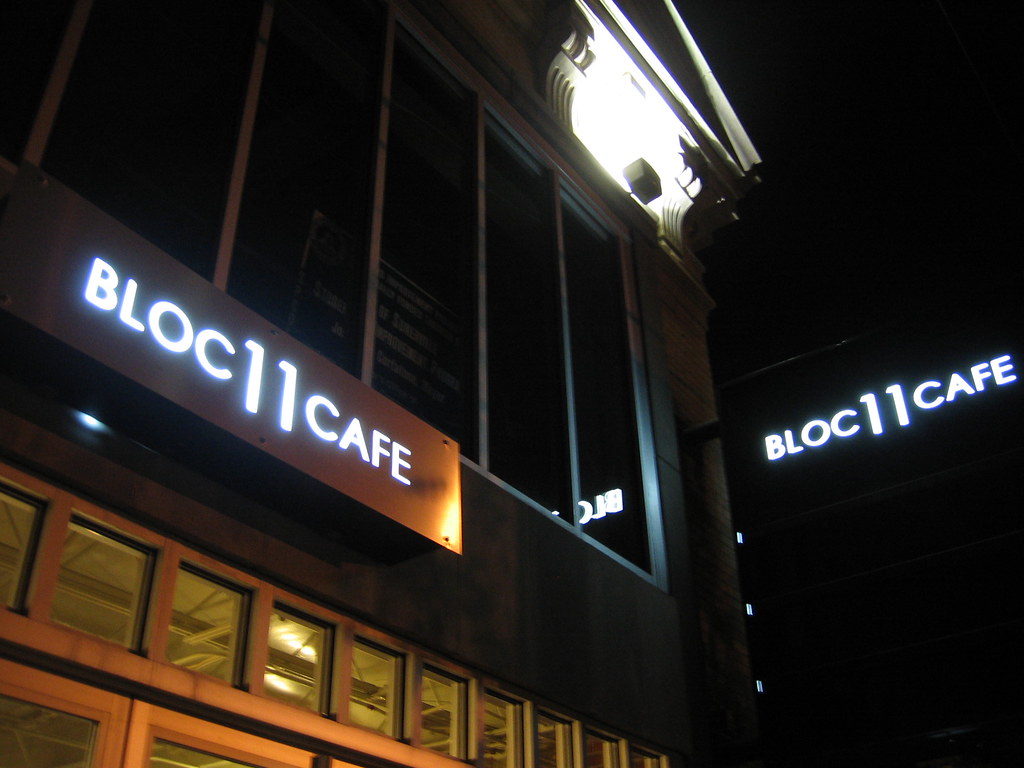
Due to demand, we've decided to move the tasting to the new Block 11 cafe in Union square, Somerville. The crew over there has been nice enough to accommodate us on really short notice and we're happy to bring some coffee lovers into their new space. We hope everyone who was planning on attending will be able to make it to Block 11 (it's not far, we promise). Same time, same day, same great coffees. Hope to see you all there!
Block 11 cafe
[where:25 Bow st, Somerville, MA]
Sunday, Nov. 18th at 5pm
[UPDATE]:
Tenative Schedule
Bob Weeks of Redeyeroasters Hingham, MA
John Mahoney of Atomic Cafe Beverly, MA
Simon Yu of Simon's Coffee Shop Cambridge, MA Presenting Terroir Coffee
OR tenatively Jennifer Howell of Terroir Coffee Acton, MA
Ben Chen presenting coffees by Simon Hsieh of 4Arts Zero-Defect Coffees of Taiwan
The theme is local roasters with the exception of our good buddy Simon who as a friend, gets an honorary MA designation so we can brew vacpot with his method. The goal is to build community awareness of the potential in coffee by sampling some interesting brews from local roasters.
[UPDATE]:
A big thanks to John at Atomic for showing up and bringing his Kenya Deep River Peaberry, Guat CoE, and Colombia CoE. Special thanks to Jen at Bloc 11 for hosting us. A tremendous thanks to Simon Yu for continuously supporting our events and footing the bill on the Terroir coffees. Thanks to Peter for sending the Colombia coffee. A big thanks to Josh for the home roasts. A thanks to Ben Chen for his home roasts, particularly the Rwanda. Big appreciations go out to Simon Hsieh for what were the coffees that capped the night in style as the Esmeralda Gr 0 floored the crowd. Last but not least, a hearty thanks to everyone who showed up. It was a good sized lively crowd of people we appreciated greatly on such short notice.
Friday, November 09, 2007
The Coffee Tasting Is On! [UPDATE]

Sunday, November 18th, at 5pm
[UPDATE]: We're currently seeking a new venue for the event due to demand, so we will almost certainly not be at Hi-Rise this Sunday. More info soon.
[UPDATE]:New location found, details to follow:
Bloc 11 Cafe
11 Bow St
Somerville, MA 02143
(617) 623-0000
Sunday, November 04, 2007
Go with the flow...
It's a coffee shop and yet you have this one problem that keeps getting worse and worse... the credit card transaction. There's nothing worse than a line full of people to the door and somebody pulls out a card for the $2 cup of coffee. People in the line groan and the person at the register swipes, swipes, swipes.... dialing.... dialing... printing... signatures... copies... ugh! Add to that the fees and a percent of every transaction, it really slows you down and really cuts your profitability.
The irony is the slick marketing campaigns bombarding people nowadays to 'use the card' because cash slows you down. So many customers still present the plastic with 'sorry' but one would wonder why cafes still accept credit cards?
Anyone who has ever worked behind the counter of a coffee bar knows two things:
The card slows down the line.
More cash equals better tips, more plastic equals less tips...
The nose knows
I have been schooled on aroma and I realize I have a long way to go still. I never believed in the generic coffee aromas we so often describe as 'smells like coffee' being a positive. That makes me strange enough already, but I learned to value the least coffee characters in coffee very quickly. Most stale bags of coffee off the shelf at your grocery store have some of this generic 'coffee' smell and at this point, it just isn't appealing to me. When I think of aroma, I like to think of the inherent origin characters, the floral tea like washed Yirgacheffe. The refined fruit floral in a solid Kenya and the sparkling sweet aroma present in a Huehue. The nutty jam aroma in a Rwanda or the honey pecan of a Brazil. Of course, I am speaking generically but the point is made. don't misunderstand me, I am not talking about acidity so potent, it cuts through the cup into the aroma. I am talking about an approachable cup with a potent aroma!
Origin aroma is the most elusive cup component. The washed coffees in particular are the most difficult to preserve unique aroma in. In a chain of events during roasting or brewing, it is quite easy to erase that aroma and leave only the acidity or sweetness. In fact, it is the natural behaviour of the beans during roasting to lose natural aroma and take on roast aromas without the user's active intervention.
Preserve is the key word here. Aroma is the first component in a bean to age away, followed by fruit character and then finally sweetness. If you accept this, it means only fresher coffees will have aroma inherent to their terroir.
A good vac pot brew may take you months to figure out, a good roast may take years, but the aromatic cup that floors you is really worth it. Now, to translate that into espresso...
Thursday, November 01, 2007
Fast, cheap, and quality
 He's always quick to point out an old saying: you can pick two of these three choices (fast, cheap, quality) but not all three.
He's always quick to point out an old saying: you can pick two of these three choices (fast, cheap, quality) but not all three. Doing something well cannot be so simple as adopting a hip mantra. The same is true on every level of coffee production on down to the cafe. While we all market and dream about ideas of coffee served in high volume cafes at cheap prices being fantastic, maybe the classic cafe just isn't a model built for great coffees. Before everyone gets all high and mighty protecting their own cafes or current employer, hear me out first. This is about the future of coffee, the CoE winners to come, and the changes just ahead of us in storage as higher prices are paid and the specialty market grows more aware of quality beyond exectution. You know, not everyone is going to leave they're prize winning coffees still sitting in jute months after harvest. Standards are changing and new attitudes are spreading.
The best brew I have had is a technically pulled vac pot and yes, espresso has been my great challenge over the years. Both take immense time and skill to get right, an investment in technique and repetition. A learning curve where a great deal of time must be invested to build a routine and understand what is happening. Producing the best cup may mean that you cannot do it cheap or quickly. We have been critics of Aeropress as a brew method and abhor french press as being the least expressive brew method available for great coffees. They are simple and they are convenient. Both are ultimately, in our opinion, inadequate for top end coffees. A cheapo darker roasted coffee, just fine, adds body and hides some of the less refined characters. French pressing Panama Esmeralda or CoE Colombia #1 would be amateurish or at least we could agree to say it's a lazy and less rewarding way to brew an expensive coffee. Doing justice to a great coffee may mean following it every step of the way with a scientific approach to preserving more at every quality point along the way. From harvest and processing, to bagging and transport, to roast and brew, everything matters. The tiniest detail can create the biggest problems when overlooked. At least that's how I feel about it these days more so than ever.
We, the Internet crowd, are opt to chime in about 'letting the coffee speak for itself' and other romancing but is it the character on the cupping table that we should all woo? Why can't it be about finding that perfect balanced chorus of notes coming through a technically timed vac pot that were faint at best in the cupping? Maybe it's a balance of roast skills and baristaing that brings aromatic harmony into the tiny demitasse. Is the barista in the way or is the barista the chef who does just enough to get the most out of the expression? The devil's in the cup, you can pour latte art all you want and wear the cool t-shirts, at the end of the day though, we all got to be chasing something. Maybe that perfect cup is just perpetualy out of reach but we must continue to learn more and invest ourselves in it to reap the rewards. Because time and quality don't come cheap and neither does a great coffee.
UPDATE:
There is an inverse relationship between effort and reward in most brew methods. Even Clover is a balance of sacrifice. As speed is desired in the brew method, a loss of quality occurs, but an increase in cost(from added technology) is able to preserve some quality to a point. The balance is keeping the speed but also having a measure of quality worth the price. You cannot have speed and quality without a high price. For that matter, you cannot have the highest level of quality without a high price AND sacrificing speed. Basic common sense.
In terms of difficulty from easy to most difficult among manual methods we use often are as follows:
Traditional Cupping, French Press, Abid, Melitta, Pour Over, Vac Pot
In terms of most rewarding to least, the lineup changes thus:
Vac Pot, Pour Over, Melitta, Abid, French Press, Traditional Cupping
You will notice an inverse relationship between the two. That's a byproduct of effort and detail applied resulting in a better brew. The Vac pot is a flatline brew(with our methodology) which gets a full extraction and the French press is a declining brew profile that is already cooling by the end of the brew time so it hides many faults as well as good characters. I don't recommend french press unless you are out camping, even then, your melitta, if properly done can produce a much better brew with only a little more effort.
I don't believe in lowest common denominator. Trying to be the everyman for coffee is great for some but I just don't find it exciting. Pushing the coffees to the limit is much more exciting. Challenging what is acceptable will always be more rewading than falling in line.
Monday, October 22, 2007
Baseball has nothing to do with coffee
Wednesday, October 17, 2007
Holy Chiapas!
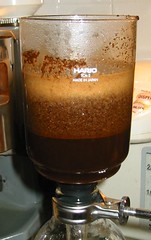 I typically do a syphon when I do any coffee at home, espresso when I have the chance. I don't think people realize exactly how hard it is to get these manual methods right. The stirring on a vac pot is hard, especially with very fresh coffee in large amounts. You have to saturate without over stirring and over extracting. Stir too much and you create a centrifuge where the fines migrate to the middle, stir too little and you get a flat brew!
I typically do a syphon when I do any coffee at home, espresso when I have the chance. I don't think people realize exactly how hard it is to get these manual methods right. The stirring on a vac pot is hard, especially with very fresh coffee in large amounts. You have to saturate without over stirring and over extracting. Stir too much and you create a centrifuge where the fines migrate to the middle, stir too little and you get a flat brew!Well, the point of this post is not the brew methods, it was my 'breakfast blend' from last nights epic roast session. Of available coffees, since I was making only one cup, I wanted to make it last longer so I thought I would blend.
Barismo Breakfast blend:
1 Panama La Hacienda Esmeralda
1 K1 Kenya, special prep lot - sooo secret we can't say it in public ;)
1 Costa Rica CoE #20
1 Yirgacheffe Idido Teramed WP
 It's sickly sweet, smooth and buttery, but darned if all the high notes just smoothed together. Blending is hard. I think I'll just stick to more interesting single coffees or pairings of two more interesting ones. I think the CR was adding nothing to the blend beyond sweetness and the Esmeralda was dominating all the other high note contenders. Sweet and juicy but hard to pick out distinct notes. A blend from last night, K1 + Esmeralda was like a knock down drag out fight for which one dominated the cup. Given the price of the two coffees, I'm not surprised. The result was something almost artificial like floral orange soda. Probably closer to Ben's crazy cherry coke idea!
It's sickly sweet, smooth and buttery, but darned if all the high notes just smoothed together. Blending is hard. I think I'll just stick to more interesting single coffees or pairings of two more interesting ones. I think the CR was adding nothing to the blend beyond sweetness and the Esmeralda was dominating all the other high note contenders. Sweet and juicy but hard to pick out distinct notes. A blend from last night, K1 + Esmeralda was like a knock down drag out fight for which one dominated the cup. Given the price of the two coffees, I'm not surprised. The result was something almost artificial like floral orange soda. Probably closer to Ben's crazy cherry coke idea!By the way, if your Esmeralda has notes like 'lemon pledge', something isn't right but I'll leave you with that thought to chew on.
I also have a good roast of a 'higher grown' Chiapas and a Nic that suffered the jute bag fate. I don't see what people get from coffees like that Chiapas. There's nothing in it but funk. It was the first uneven roast we've had recently, two distinct sizes/colors and absolutely no positive or interesting cup characters, just mixed light funk. Sure, at close to second crack, it will be dark generic coffee flavors, maybe some cocoa and less funk, but I guess my palate is not good enough to get it.
Monday, October 15, 2007
What is it with double entendres and coffee?
 We have done a lot of crazy experiments. Some were very rewarding and a great many were very educational dead ends. Cold brew was interesting, aeropress, not so much! Suffering through a few months of poor roasts where it seems we went from supposedly good roasts to suddenly not being able to handle anything left us quite irritated. Months of perseverance let us explore all kinds of tiny tweaks and variances that might lead us to the holy grail of roasts, so to speak. Thankfully, our roasting has finally shown some rewards as we continue to pursue our dreams of fragrant espresso, at least until it falls off the table and we have to reboot our whole profile once again.
We have done a lot of crazy experiments. Some were very rewarding and a great many were very educational dead ends. Cold brew was interesting, aeropress, not so much! Suffering through a few months of poor roasts where it seems we went from supposedly good roasts to suddenly not being able to handle anything left us quite irritated. Months of perseverance let us explore all kinds of tiny tweaks and variances that might lead us to the holy grail of roasts, so to speak. Thankfully, our roasting has finally shown some rewards as we continue to pursue our dreams of fragrant espresso, at least until it falls off the table and we have to reboot our whole profile once again.  Right now, we are pursuing a little project of sharing some roasts with friends to get some critical feedback and really open a dialogue on what we are tasting. Describing something you like is really quite hard when only you can taste it, right?
Right now, we are pursuing a little project of sharing some roasts with friends to get some critical feedback and really open a dialogue on what we are tasting. Describing something you like is really quite hard when only you can taste it, right?Meanwhile, most of our tiny green collection is tidily stored away right now. Vacuum sealed with secret techniques applied to preserve the green. A quick thought though about storage, suppose you are Wendelboe and your Wendelspro is showing signs of age in the green department, what do you do? You have black week when fresh new coffees arrive and then celebrate. To reiterate a question, why don't people spend more time figuring out how to keep it from getting old in the first place?
Sunday, October 14, 2007
The sweet potato is cooked
If that makes any sense to you, you might be quite ahead of the curve.
There are a bundle of terms that we have from 'green' astringency to 'pencil lead' bitters and of course the 'baggy' and 'bakey' from a variety of variables. It occurs to me that the bakey descriptor is a hard one to quantify as it can be anything from a full on cardboard 'generic coffee' aroma to a simple oft unnoticed dulling of aroma and fruit. My favorite though is the term 'charr.' It's what we use to describe the caramel note imparted by the perforated drum. For instance, you may bake corn in an oven vs over an open grill. The latter being our little roaster. Easy to burn and hard to cook through but the reward of getting it just right is an explosive balance of mid tones AND fruit in the same cup.
My least favorite descriptor is acidity and you won't see me use it much to describe a pleasant coffee. Acidity is really a misunderstood term so I propose we simply rethink it or at least use it more sparingly. It's just too all encompassing of the good and the bad without distinguishing either. Many strongly acidic coffees can often be attributed to either a roast byproduct(intentional or not) or a problem with the coffee. A bit green and improperly dried where the astringency is often erroneously described as acidic is something I have seen quite a bit of. When the acidity is pleasantly balanced, not a byproduct of error or defects, then I typically term it as fruit which it will often resemble. A nice cup of coffee can have ample fruit character without closing your throat or turning your stomach. A fruity cup can be juicy or jammy but it shouldn't curdle your milk!
This one particular coffee we roasted tonight is a strong Kenya. Powerful aromatics and fruit in the cup like a pleasant Lychee or Longan fruit. Something tropical and sweet but I dare not say it's acidic in the classic manner. Past roasts where a green astringency showed through after days of rest were most definitely acidic/tannic/astringent. This roast was decidedly sweet and juicy with a popping aroma which beats down the roast we did only two days earlier that we were wowing over. It has a nice acidity but it's not acid nor acidic, therefore I just call it fruit and be done with it. Maybe acidity is a dirty word in many circles but maybe we just need to understand it a little better instead of throwing a big blanket over it all with one generic term.
I really believe building a vocabulary is key to quantifying many different things. Since we had nothing to point to, no guide, we defined our own roasts in our own terms. Mostly the errors as we saw them and quantifying the resulting tastes of those errors. This must have really confused our Taiwanese friends who did a double take at our desire for less 'roast' flavor in the coffee. I mean, coffee is roasted, so all the flavor is roast but we were so tired of that dull bitter smoke that we referred to it as 'roast' flavor. A singular note that stood out from the rest of the coffee flavors that was often simply akin to hardwood smoke.
Even in espresso, I use the term bile to describe one sour and acidic to describe another because depending on which is prevalent, you may need to decrease or increase the brew temp. Quantifying things in relative terms is just a simple aid to relating and understanding what you are tasting and relating what that comes from. Be it in the roast or in the brew method, a label helps even if it sounds funny or a bit silly.
Thursday, October 11, 2007
Blind lemon toast
From a basic, " this is horrible" to the hilarious " welcome to the bakery," it was a fun night of what if's? Not a single good shot but we confirmed a lot of theories. A phone call to another barista using the same espresso reinforced that the machine was absolutely not the problem here. I didn't suspect it was but the call confirmed it. Poorly roasted Brasils seemed to be the culprit!
It was great fun overall and the old timer left with a curiosity to taste some direct flame roasts.
A quick call or two with Silas established his reinvigorated desire to be in coffee... at least until the teas get better! Edwin is on the way into town so keep an eye out for him and Nina. The roasts are getting better and we did a quick round of some guat coffees for our expert visitor to critique. It will either fall apart or be interesting enough that we can continue on and send some friends coffees promised long ago.
Saturday, October 06, 2007
Nordic Espresso
A lovely package arrived:
Kontra Espresso Reno 1.3:
Yirgacheffe, Ethiopian 40%
Quebradon, Colombia 35%
San Luis, El Salvador 25%
Tim Wendelboe Espresso:
41% Fazenda Santa Alina, Brasil
20% La Esperanza, Colombia
18% La Montanita, El Salvador
11% Eeagads Estate, Kenya
10% Bukonya Estate, Rwanda
The Coffee Collective:
50% Daterra Sweet Collection, Brasil
30% Finca Vista Hermosa, Guatemala
20% Ily Deratu Harar, Ethiopian
Estate Coffee 4 Estates:
Daterra Sweet Collection, Brasil
La Minita, Costa Rica
JAZ de Rico Coco, Nicaragua
Santa Cruz, Mexico
Kaffa Forte & Crescendo:
Colombia La Vega
Guatemala Estate Culpan(Bourbon)
Java Kayumas
Ethiopia Sidamo Shilcho
Thanks Chris and M'lissa!
Thursday, October 04, 2007
Hand pour drip method
Saw this on saueshen's blog. Once again reconfirmed for me that we don't know squat about manual methods...(and why there were competitions for these sort of things...).
Notes from the curb
Consistency.
I told him I have a good batch, a bit dark cocoa, mellow and nutty as a tight shot, but the last batch was pretty rough at any volume. The whole week has been rough because I simply cannot control what's happening and adjusting to the odd situations as well as the coffee becomes a constant battle. My milk is up to specs and I have a good feel for shots as I know the groups better now, but I have simply had a few days where I knew I was helpless. No adjustment or tweak was going to help where the beans were at. It's that lack of control that proved trying but served a good reminder also. It was a good idea to get back on bar before my next project.
I think what struck me was the conversation about repeatability that followed. 'How can you market espresso with such elusiveness?' he complained. He lamented the state of espresso and how our approach has wandered so far from the manual methods that we have forgotten the basic physics of brewing. He related how he felt that with all the mechanics and upgrades, we were simply chasing the cup that came from a very experienced artisan on an old lever machine but we can't get back to it. He felt that we had moved away from understanding the cup itself. The green got better but were the brewing methods getting better? 7 bean blends, robusta, HX, and a multitude of other topics quickly followed as a history lesson to prove the point. He showed me a perceptiveness and honesty that was refreshing.
He told me he ordered parts to help Simon alter the old 4G Linea with a delay timer array. I have been able to convince him it's worth a shot and he is willing to pursue it. He relates it greatly to the experiences he had years ago repairing the old lever machines and believes with a few changes to line pressure, he can imitate some of the physics in his older approach. Having never used levers, I can only rely on his experience with them but it makes sense as he explains it. I know the machine needs a tweak for Simon's sake and he may be the only person willing to help.
I feel comforted that this old timer understands me more as it had been very frustrating relating to others, including him earlier, as to what I was chasing. It felt good to have someone who was an old timer who could relate. We had a long conversation the day before about interior scorching and a feeling that a roaster we knew was approaching espresso as if it was drip coffee. In effect, focusing on acidity with a quite fast roast and then a hard pull which is a contrast to the Nordic method (read the espresso description minus the harrar) us barismoids are curious about. I realize now, we had been using the brew method to tone down the acidity in an attempt to get something that resembles but isn't quite the equivalent of the cup we desire.
Preserving aroma and highlighting sweetness with a refreshing clarity.
Sounds like a plan. Either way, the old timer brought his friend, 'the father of creative culinary in Boston' as he put it, back in for a double and a pot of Silver Needles. I have a little time to digest the conversations and in the meantime looking forward to a bag of coffee en route from the Nordic cup via friends down south.
Friday, September 28, 2007
"Barismo Spec" EC/EP Hybrid Tamp - LTD LMWDP Version

"Barismo Spec" EC/EP Hybrid Tamp - LTD LMWDP Version - 3" Tall Handle & Brass Bezel
Now available to the public through EPNW
From Espresso Parts: "Well they say great minds think a like... I don't know if we qualify but the Barismo guys have a great mind for coffee and espresso alike.
First and foremost, what is the "B-Spec" or "Barismo Spec" Tamper? Well currently our version of the "Barismo Spec" Tamper is an matte finished Espressocraft tamp handle and custom brass bezel mod'd to fit the classic Espresso Parts height convex piston."
Having been lucky enough to participate in the HB tamper road show (thanks to Dan and others who helped organize) and get a feel of several prominent tampers, we did a review. After analyzing them, there was not a clear winner. There were handles that were nice and a base that worked but there was a lack of the complete package. Take into consideration that we were thinking of a cafe prototype rather than a home user tamp and you can understand some of the choices made as Ben C. put together the mod. Our first evolution arrived and we had a pretty comfy if not absolutely gorgeous tamper.
 There was a lot of discussion about the piston height and we had a strong interest in having pistons that came level with the basket if the dose was correct which came to a satisfying conclusion. One more piece in consistency relative to our espresso OCD solved. After some mucking around and grabbing a few early versions of B-Spec from ESPNW, one more mod was added to really put it over the top. Ben decided on a sand blasted matte finish that added a comfy feel to the grip. We highly recommend you also get the EspressoParts S.S. 58mm convex base machined to a "c-flat" hybrid shape then mirror polished if you want to be hardcore and follow Ben's B-Specs.
There was a lot of discussion about the piston height and we had a strong interest in having pistons that came level with the basket if the dose was correct which came to a satisfying conclusion. One more piece in consistency relative to our espresso OCD solved. After some mucking around and grabbing a few early versions of B-Spec from ESPNW, one more mod was added to really put it over the top. Ben decided on a sand blasted matte finish that added a comfy feel to the grip. We highly recommend you also get the EspressoParts S.S. 58mm convex base machined to a "c-flat" hybrid shape then mirror polished if you want to be hardcore and follow Ben's B-Specs.
Wednesday, September 26, 2007
The fleeting moment
There was a roaster, once upon a time that we had faith in. It was a few moments of excellence that gave us that faith. A sampling here or there of coffee that was unique and really provided a startling look at something different.
The problem lay in the fleetingness of those moments. A one off bag that just rocked an amazing character and then disappeared leaving you wondering if it ever existed in the first place. One after another, we bought sample after sample to share with friends in travels and were sometimes flat out embarrassed by the results or lack thereof. This further stressed an already testy relationship but that's not what the post is about.
One of those defining moments early on was a Yirgacheffe as SOE. A WP Gr2 that on the cupping table was somewhat boring but in the espresso machine was singing. After experiencing this, I remember telling the company owner how I loved Yirg for the aroma above all else. The aroma? He looked at me with a confused sort of 'You don't get it' look. He was right, I didn't get it but equally, I thought he must never have experienced it as a shot the same way I just had. It was part of a turning point where our paths diverged and our group set out in a different direction.
Today, after more than a year from that experience, I had another one off experience that reminded me of that Yirg moment. I was grinding a bag of Yirg for a customer and I smelled that floral note. Defined and present, it was obvious but at first I thought I was delusional. I mean, I have tried this coffee several dozens times since that experience and it had nothing in common with that fleeting moment and yet, maybe... As soon as I finished, we grabbed several retail bags and began furiously pulling shots. Four shots in, a matter of fact 'there it is' was blurted out as I could smell it in the pour. That heady nose of floral was back and leaping out of the cup.
I was dumbfounded. I chuckled and listened to my cohort describe 'apple jacks' aroma and malty brown sugar in the cup. I mean, you have to be kidding me! After months of lemon ginger blah, I get this... It wasn't perfect but it was there and I had to wonder if this was the same coffee. I left a bag in the hopper and then promptly took the rest of the bags for myself! I hope the remaining bags are the same but I don't pin much hope on it as I have learned to simply enjoy those experiences these days. The rest of the night was simply spent chuckling at the silliness of it all.
BTW twas: 1.5oz 28sec 17g 196F
Tuesday, September 25, 2007
Smelling the puck
I have been wondering lately a bit about the old folks and some of their weird habits. A local old timer of coffee always has this habit of smelling the pucks constantly between shots. I wonder what he is trying to accomplish sometimes and what truth lies therein.
I know when you do an excellent vac pot, the aroma shows up nicely in the grounds and the 'sweetness' is evident. Would the same be true in an excellent espresso?
I don't really have an answer but some pucks sniffed today did have a very mellow sweetness in the better shots. I couldn't really correlate anything to form a theory and with the espresso as it is, I won't venture absolutes. The smell thing does make me believe there is something to it though even if I were to acknolwedge it, I don't know if I would change my routine much.
Monday, September 24, 2007
barista-ing
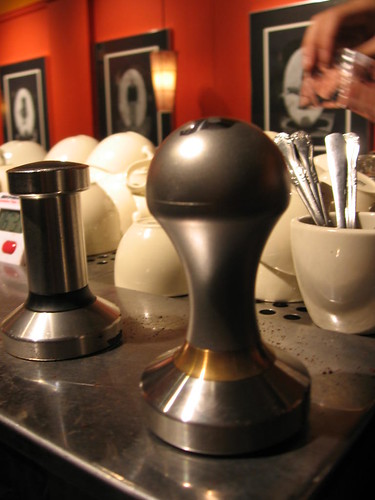
I was pulling a bar shift. Ouch my thumb, time for the fancy ergo tamper. The logo makes the espresso taste better... er, maybe not but it is cool and not the least bit dorky.
It took a little while but the latte art and portions are tight right now. The espresso was making me unhappy though. Surprise. When would I be happy with it? The beans are quite funky and suffer a tough pungency that reminds me of our early popping roasts that we simply throttled dark in vain attempts to save them. Don't know what was going on there. That and a depressing lack of straight shots put me in a sour mood at first.
In a positive turn, I put down a small lineup for a trainee of a french (near fire alarm) roast of Costa Rica, a light roasted Guatemala, a medium Panama, and a light roasted Yirg(sample roast). She nailed the descriptions on the first try.
Yirg: light, some acidity
Panama: Clean, mellow, some roast
Guat: Very acidic
Costa Rica: Smoke
I was quick to point out that now she had just formed an opinion she could relate to the customer. I thought it was interesting to see someone just pluck that out so quickly. Sometimes you get confusion over bitters/sours but this was quick, dirty, and accurate.
The rest of the evening I was sparked into detailed conversation with any customer interested in chatting. I realized how much I enjoy customers who can go on about the flavors they taste in the cup. When you can get a customer talking about what kind of flower or describing the specific citrus, you win. Those customers don't just happen though, in a way, you have to cultivate them. Engaging people in that kind of discussion also makes coffee fun. It's like a medium that sparks a conversation and sometimes a relationship. Without that human connection, you are just some guy in a room making up descriptions ;-) Two of you somehow makes it normal! The barista as a salesperson, sommelier, and sometime coffee server... now that's a familiar thought.
In many ways, I had to get back behind the bar for a reality check. To revive my love of interacting in the cafe over a cup of coffee. It's a short stint but it is proving to be just what I needed to regain some momentum and refresh my perspective.
BTW: The Panama was actually from Redeye, a local roaster in Hingham. It was Diamond Mtn from Hacienda La Esmeralda. I was surprised by how nicely it aged and what a clean coffee that is. It came out very smooth in the fetco.
Sunday, September 23, 2007
Sweet Yirgacheffe
Moments like that are what it's really about for me. Sitting in a car quietly sipping a coffee simply in awe wondering what the heck happened to create that cup in that instance. I have a lot of things circling me right now, projects up in the air and big ventures about to begin but it's great to simply remind myself what I want to work towards. When a consumer can sit and have that same moment like that, that's when I will have succeeded. It's not about outdoing the next guy or being right, it's about presenting that unique taste experience.
Sunday, September 16, 2007
The Green Monstah
This post is for Nate, Snoz, and the Fettered by Secrecy Roasting Society (FSRS).
At my last time on bar, I had no real idea how important each phase of roasting was besides an understanding that it was hard because even the best struggled with it. I knew that sometimes the roasts were ashy, sometimes they were flat, and sometimes bright as there was a lot of variance batch to batch. Each week, it was a new experience and a test of patience. How can you raise the bar if the base is shifting?
After struggling for months to get evenly dried sample roasts while working the wettest/highest grown/most expensive green we could find, I have a few thoughts to offer. I now have suffered enough to realize that there are several layers of difficulty in roasting that the majority of people aren't always able to piece together. This site isn't a roasting how-to so let me give you a few things to chew on and think about for yourself instead of spoon feeding you something. Let's play myth buster for a moment.
Myth Number One: Light roasts are grassy, you have to roast darker to avoid this.
Truth: Light roasts that are dried properly will not be grassy. If you don't know what that means, it's time to do some research.
Myth Number Two: You have to slow down.
Truth: Yes and no or rather a maybe. Some people slow down and bake which does nothing positive but does mask the hot cup character a lot without fixing the real problem. Since each roasting setup is different, you figure it out for yourself.
I am theorizing that most of the major errors I am seeing in commercial roasts appear to be a product of improper drying either inefficient or uneven. If you can't get the head right, what good is finessing the tail? The pretty labels sure don't help and the barista can't change a thing.
What does 'bakey' taste like? What does 'green' taste like? Got something to chew on now, eh?
Thursday, September 13, 2007
Coffee tasting at Hi Rise
October 20th at 5pm
Hi-Rise Bread Company
[where: 208 Concord Ave Cambridge, MA 02138-1335]
Coffee cupping event. Free to the public. Coffees from local roasters, vac pot, pour over, and other brew methods just for fun. Sorry, no espresso planned at this time.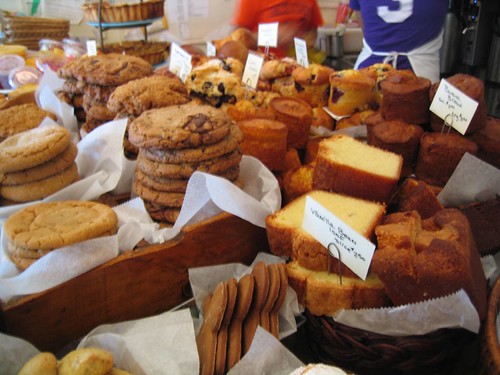
Should be good fun. Hopefully some local roasters will come in to present their own coffees on this stage. Hi Rise has a great community following and really is a solid place to have events like this. I am really looking forward to it.
Date and time subject ot change so keep tabs on us.
An array of roasters
Roasting is about scale. Simply put, bigger is more consistent, but it isn't finesse. How do you overcome that? An array of small batch roasters so you can finesse your roasts.
It's an idea worth borrowing.
Here and there
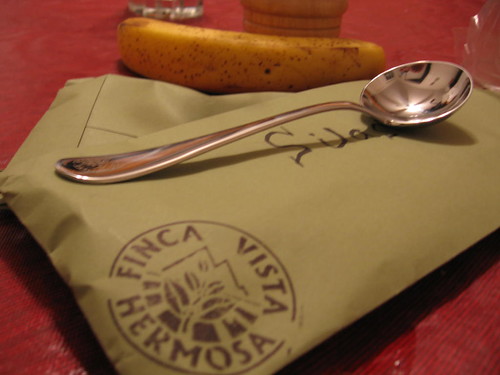
Big props to my friend Edwin for sending us some monogrammed cupping spoons. It's actually the first real cupping spoon I ever had. I don't think I ever really thought about buying one for myself because that's how we are. I kinda cringe at being the person who walks into a cupping with spoon on belt/over the ear/tied to arm. Yep, we all know one of those types.
Still, it's sweet to have one so maybe I'll have to get a bandanna for my arm to carry it around now.
I am looking forward to Eddie and Nina's visit and hopefully it will prove as entertaining as when Blanco dropped in.
This all goes to remind me that Friday will be a travel day out to Hingham to visit Bob's outfit, Redeye. Interested to see how he roasts the Panama 'Diamond Mountain' and the Gayo among others. Kaminsky and I will join a new kid who is opening a shop somewhere in the Boston area.
Monday, September 10, 2007
The same old same old shot
I thought I would categorize them a bit and I came up with six categories:
Earthy
Tobacco/Leather
Chocolate
Caramel
Fermented/Monsooned
Paper Bag
There are many blends where you end up with crossover between each category. Maybe I should have included an honorable mention for Lemony but I felt it was so uncommon, it didn't deserve a category.
Earthy: Think sumatra, spicy, things you would find in a forest: wood, mushrooms, leaves, mold, mildew.
Tobacco/Leather: Tawny, spicy: think about your first triple ristretto. often has crossover with earthy/chocolate.
Chocolate: Think bitter to bittersweet, sometimes milky, rarely though. You can put chocolate in anything with a rolling second crack but many espouse the use of certain beans for this enhanced cocoa. Seriously, cocoa is the roast.
Caramel: Think caramel without the sugar, without the sweet. Most caramel espresso are polished to the point the only character left is a smooth caramel, sometimes burnt sugar but rarely if ever sweet.
Fermented/Monsooned: Fermented: think booberry or strawberry(harrar, sidamo, or other naturals). Monsooned: Mushroom ugh maybe anise at 203.5F(Malabar). Why lump them together? Because both are coffees where the processing is an anomaly.
Paper Bag: Paper bag: think cardboard, burnt rubber, bitter. Yep, you guessed it, Robusta.
The are not a lot of unique espresso out there to be had. Simply put, a lot of them suck, a lot of them are boring, a lot of them taste better in milk than straight shots.
There are intriguing endeavors, but for all the noise coming out of the forum community, you'd think there would be more... right?
Hmm, sweet aromatic espresso. Some fruit, some nuts, no dirt, no mold, no spice, and a lot of character would be nice for a change every now and then even with some cocoa if it was more sweet than bittersweet. An aftertaste that makes your mouth water would be nice instead of a lingering bitterness also :-p
Saturday, September 08, 2007
Wednesday, September 05, 2007
Tragically Hip Coffee People
It's funny because the old third waver punch line is a not too subtly ironic, 'it's all about the coffee.'
Wednesday, August 22, 2007
This has nothing to do with coffee
The best thing about road trips is that final stretch on the road getting back to familiar signs and that cozy strip of road you frequent most. Radio station presets come back in tune and you can shake off the fatigue for a second wind as you know you are close to home.
Now that I'm back in town, a few notes for my fellow Cantabrigians:
- If you are a Cambridge Barista, there's word of a local event. Still looking for sponsors, music shops, bike shops, etc to make it happen and a bar for the after party. I'm supporting as best I can, email me if you want to participate and I will forward you to the organizers. Highlight will be a latte art throwdown and some free swag.
- An event upcoming in one month. This will be a big event. Owner agreed to this as long as we take it very serious and put together a good show. Vac pots and lots of coffee. Interested roasters need only drop me an email. You get the stage with at least two of the areas best shop owners and a crowd of hi flyin consumers with good palates at one of my favorite locales. Details will come up on the site closer to event time.

Gratuitous latte art parting shot...
Monday, August 13, 2007
$15 per 8-oz cup ($135 per half pound in bean form)
Bloggle makes note of Panama La Esmeralda getting Vancouver press for it's uber expensive cup price. We over at barismo have long been trying to underplay the hype for many reasons but it's time to lay a few thoughts/questions on this coffee:
Saturday, August 11, 2007
Friday, August 10, 2007
Do your homework
First of all, coffeegeek is a "home" enthusiast site. Sure there are some pro's lurking around but main user base are made up of a really niche group of coffee drinkers. In fact, I am speculating that coffeegeek prob represent less than 5% of your actual customers. As such, the feedback you get back from the forum is very skewed toward this user base. Also, since most of the knowledge is focused on home users, the advices you got will most likely be not applicable in a business setting. Seeking advices regarding the coffee business on this site just showed how lack of knowledge you have. If you need help from coffeegeek, you really should not be in the business.
I also found this VERY insulting as a person who is somewhat connected to the biz. Pay your dues and do your own research. The answers are out there. Looking for a easy answer is just pure laziness. Please do not call yourself a coffee professional if you cannot even do this.
Oh btw, free advice is just that. Sometimes it takes a lot of time and money to educate yourself. That is just a fact of life.
Mulling espresso
We have written a lot on our love and frustration with Espresso, so rather than boring you with some long recycled rant, let's refresh a few old rants.
Blends are a compromise - This was the point way back where we began consistently using the term alchemy to refer to the approach in espresso where poor grade greens are in effect blended with the idea that the end result will be something superior. It was a basic lament that if we blend, why not use a handful of very expressive components instead of a stable of lackluster ones. Great comments too!
Tell me how you really feel about espresso - This was a solid account of us as we began our affinity for vac pots. Even as I fell in love with the Hario, I still had a strong desire to go back and pull shots of Kenyas and Yirgs and get closer to that candied fruit and aroma we saw glimpses of before.
You can dig through all our old notes of pulling Yirgs and Kenyas if you like but what good are cupping notes on coffees no longer for sale or roasts that have changed so much our notes would be irrelevant? A bit of foreshadowing and hints of things to come in the comments...
Lemony Espresso - The picture sells it and this was really part of a long line of frustration illustrated in many of the posts on the site.
Clean Espresso - A snarky breakdown of how we defined clean espresso.
Clamouring for espresso... and didn't know it? - An oldie bout the good ole days... hopefully to return shortly. Note the date on the article and don't hold me responsible for the current shop changes should you visit.
The skilled hand of the Barista... - This post should be called the diary of a passionate barista. It is a great perspective on me and the belief in the untapped potential of the professional barista.
Tuesday, August 07, 2007
Scorching, tipping, baking
A quick refresher. Scorching is the ashy dull taste visually indicated by a dark line in the bean. Tipping is a funny little black ashy mark on the end of the bean alluding to much the same off flavor.
Why does it happen?
Too fast, too much drying, uneven roasts, and cooling problems to name a few.
How do you fix it?
Know your roaster and the physics behind it. Use that to your advantage or change what part is holding you back.
In terms of roaster errors, baking is most interesting because it's quite common. Bakey in it's worst is this horrible flavor that dulls out everything in your coffee. It's like a cardboard flavored cake. Not really acidity or bile sour but like an intense gassy sour flavor. Baking is often stated as simply too slow. Well it's not exactly too slow, but if you want more detail, pay me to teach you. Ha, you thought this site was all idealistic and free info for everyone.
It isn't.
That's not really the point though. If you don't know what a bakey coffee tastes like or a tipped/scorched roast flavor/appearance, as a barista, how good are you really? A roaster who consistently has this problem has no legit excuses but should a great barista understand those flavors when they appear? I used to think I knew my stuff but there were days I really could not pull a good shot. It wasn't until I stepped out from the bar and really began to learn more that I began to expand my palate and because of the frustrations with a local roaster's inconsistencies that we were almost forced to roast. If you want a good cup, control it all from start to end, right?
Sounds simple but it's hard.
In fact, it sucked. It really really sucked. I can't put enough emphasis on how bad it was. I think we roasted more than 40lbs 250g at a time before we had a few drinkable roasts. Green, astringent, acrid, scorched, baked, flat, baggy, moldy, you name it, it was all swill at first. We tried profiles being floated by pundits and internet personalities, we did a little 'research' on roasters we knew to understand their approach. In the end, we found flaws in many and completely disregarded others going in our own direction.
Why?
Because every machine is different.
We had to learn our machine inside and out, make big changes and then keep roasting because roasting is very machine dependant and so many internal/external variables can affect a roast. Do we feel any closer to perfection, ask me after another 100lbs of sample roasts, but at least our mistakes and research are drinkable now and I am happy with the sweetness though it might need a little more 'Technicolor.' I dare not mention how much we have spent on green or the hours toiled behind a roaster tasting and making gut decisions about what went wrong. Most of the time, only two of us in an 85 degree room with tempers flaring and nothing to show for it.
Good times.
Will I write much more about roasting on the site, no, not in much detail anyway. My cups are pleasant enough that I have nothing to complain about so I will leave you with this.
Scorching, tipping, and baking....
Don't do it and don't put up with it from your roaster either.
Thursday, August 02, 2007
The Syphon Bar
Seems everyone is doing vac pot these days or at least giving it lip service. Getting a first read on a signed edition of a fantastic and thoughtfully written new coffee book (to be shortly reviewed) brought one thought though.
We don't know vac pot in North America. In fact, we largely have forgotten or overlooked most of the manual brew methods with the exception of the largely inferior french press method. Someone offered this thought to us recently and I dare say it has some truth, 'If you don't know your manual methods, what understanding do your really have of your automated ones?'
Scary thought that knowing a better hand pour method translates to a better drip brew.
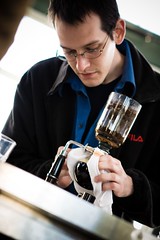 Our own jump into vac pot (syphon) and our exploration of hand pour methods came thanks to a Taiwanese contact who helped us along with inputs and pointers on how to brew his coffees.
Our own jump into vac pot (syphon) and our exploration of hand pour methods came thanks to a Taiwanese contact who helped us along with inputs and pointers on how to brew his coffees.It led to a thought, 'let's do vac pot in the shop.'
Oh yeah, many other people have had the same thought. That thought began to morph and fade as we realized it wasn't quite as simple as throwing a bar together and offering it up. How do you keep it constant and consistent? how do you charge people given the amount of coffee and prep needed? How do you keep your staff well trained enough to prepare it correctly for each and every different coffee?
The roast. You would have to roast for vac pot and make sure the brew parameters were largely fixed so your barista would only make slight adjustments. Fix your brew parameters and alter your roast profile to fit. Strange concept but darned if we hadn't heard the same thought before from our Taiwanese friend.
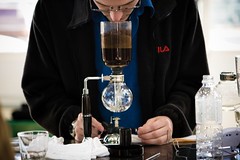 So here's a bit of advice before anyone goes out and buys a case of vac pots and a halogen setup, learn more about it. The Japanese are having true culinary competitions while we still noodle around with it not quite understanding the physics. It may be the hip thing to do vac pot but a little research and thought may be in order before burning yourself and your customers with a bad brew.
So here's a bit of advice before anyone goes out and buys a case of vac pots and a halogen setup, learn more about it. The Japanese are having true culinary competitions while we still noodle around with it not quite understanding the physics. It may be the hip thing to do vac pot but a little research and thought may be in order before burning yourself and your customers with a bad brew.Vac pot has a lot of potential to bring out amazing origin flavors but it's much more technical than many of us realize. The old light it up and steam the coffee to death method just won't cut it compared to a precisely technical approach, so get to learning about your manual methods and your more automated ones will improve also.

Saturday, July 28, 2007
Boston eXpresso can be suprising...
More quirky photos available on Brown Coffee's Flickr of Mr. Blanco's food stuffed yet brief trip to Boston.
UPDATE: So the story behind this photo is when Mr. Blanco wanted to try a shot of Terroir's Northern, we headed over to True Grounds in Ball Square, Somerville. We go in and I decide to opt for a bottle of vitamin water with Hong trying to remove myself from any opinion on the coffee. Blanco has the gall to order a 'double ristretto' somewhat in jest and after some discussion is served a 2oz+ expresso. Silas then orders a regular double espresso and the guy gives him what at first looks like an americano but after a few sips, it's all eXpresso. I honestly don't know what happened, if there was confusion, or if that's the way they really serve the espresso there. I'd laugh but I felt bad about it.
It reminds me of when Someday Cafe in Davis was still open serving Northern, they used to ask 'Two shots or Four' when your ordered an espresso.
Miguel (he's peruvian, not mexican!) played dirty biker hand model so you can get a perspective for the sizes of both the large 3.5oz demitasse and the latte cup the other drink was served in.
Please feel free to leave your own version of what our commentary might have been...
Monday, July 23, 2007
Third wave, fourth wave, fifth wave...
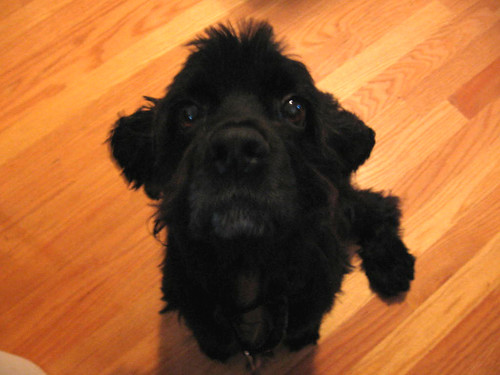
This is Roosevelt. Rosie to some, Idgy to others. Roosevelt has a dirty mouth.
I wonder if most dogs can tell the difference between good food and bad or they just simply eat? I have definitely had some picky pets in the past who would turn a nose up at 'pet food' opting for what was on my plate instead so I'm inclined to think they could be discerning. Rosie is not of that ilk though.
Obviously, this post's not going to be about my mother's spaniel, it's about us as foodies and coffee aficionados. We eat so much processed food and so many items that are simply of questionable quality that I often wonder what is our food culture? Do we just simply put stuff in our mouth and say, well, it tastes good with little thought to quantifying that feeling... or is there something more to it.
What is good taste? How do we define quality?
It brings up the thought that what I believed was great only a year ago, I doubt would make my top list now. That is a statement about my evolution in coffee and the way our perspective has been shaped. It began with fresh roast and 'not burnt' then migrated to a myriad of qualifications including how it was processed and at what elevation it was grown. I really began to notice how much our group has changed in our perspective of coffee over the last year after our most recent cupping session. Sitting at a table with Silas and Judson while Ben manned the sample roaster gave me a renewed feeling of direction in coffee which immediately made me look back on how we got there.
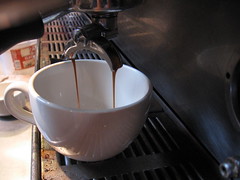 Many people getting into coffee, who use the Internet, will start with a site like coffeegeek.com. For a while, it's like an epiphany. Pull thick chocolate ristretto shots, take photos, repeat. Life was good. Then things quiet down and after a while those chocolate shots were becoming boring and a lot of people lose interest. Some people fade away and move on to other interests thinking they had mastered some angle of coffee at that point. Others moved forward and found home-barista.com and it could provide a more serious place where technical people converged and pontificated 'what if?' After time though, the mods and hacks came to an ending point where everything was PID'd including the toaster and there seemed to be little more to explore for the coffee enthusiast.
Many people getting into coffee, who use the Internet, will start with a site like coffeegeek.com. For a while, it's like an epiphany. Pull thick chocolate ristretto shots, take photos, repeat. Life was good. Then things quiet down and after a while those chocolate shots were becoming boring and a lot of people lose interest. Some people fade away and move on to other interests thinking they had mastered some angle of coffee at that point. Others moved forward and found home-barista.com and it could provide a more serious place where technical people converged and pontificated 'what if?' After time though, the mods and hacks came to an ending point where everything was PID'd including the toaster and there seemed to be little more to explore for the coffee enthusiast.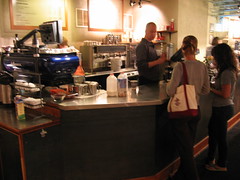 A peak, not the end of the road but to the limits of experience, knowledge, ability, access, or simply budget. For me, what I naively thought I mastered long ago still remains a mountain in front of me today because quite simply, as I learn more about coffee, I realize just how hard it becomes to learn each little bit more. This potential keeps me going. That next 5% looks like Everest in the distance but it's a mountain worth climbing. It's a harrowing thought to think that with all these fancy cafes popping up and pocket emptying bids for coffee, it only means that it doesn't get easier from here on out. The competition will get smarter and tougher as everyone tries to best 'the best.' it may be jaw dropping bids for coffees that may be hot names rather than good coffee or it may lead to a roaster's renaissance where roasters compete to get the most from every super expensive coffee. I dream of that roaster's renaissance someday because then there will be so many great cups out there to be had.
A peak, not the end of the road but to the limits of experience, knowledge, ability, access, or simply budget. For me, what I naively thought I mastered long ago still remains a mountain in front of me today because quite simply, as I learn more about coffee, I realize just how hard it becomes to learn each little bit more. This potential keeps me going. That next 5% looks like Everest in the distance but it's a mountain worth climbing. It's a harrowing thought to think that with all these fancy cafes popping up and pocket emptying bids for coffee, it only means that it doesn't get easier from here on out. The competition will get smarter and tougher as everyone tries to best 'the best.' it may be jaw dropping bids for coffees that may be hot names rather than good coffee or it may lead to a roaster's renaissance where roasters compete to get the most from every super expensive coffee. I dream of that roaster's renaissance someday because then there will be so many great cups out there to be had.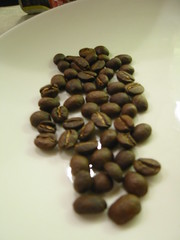 This reminds me how George Howell often pontificates that this industry is 'in it's infancy.' I wonder if he understands how deeply truthful that rings. We chest thump about the skilled barista, competitions, and artisan roasting while we simultaneously battle uphill to simply have a common language of what quality might potentially be. I have no criticisms to lay, only a simple question.
This reminds me how George Howell often pontificates that this industry is 'in it's infancy.' I wonder if he understands how deeply truthful that rings. We chest thump about the skilled barista, competitions, and artisan roasting while we simultaneously battle uphill to simply have a common language of what quality might potentially be. I have no criticisms to lay, only a simple question.If this is the beginning, what's next?
Saturday, July 21, 2007
Baked goods and pastry shops
Kaminsky was pointing me to check out the much lauded Flour Bakery. A quick bit of google research found it was handed many awards and publicity which probably justifed a closer look. We decided to visit the original location and see what they offered.
This morning, we headed over and got a selection of the menu and sampled it. The baked goods are above average but not necessarily the best in town. If Diesel in Davis was a bakery, it would be Flour. The flow is worse than Simon's(yes it's possible) and the dozen people flowing over top of each other behind the counter proved an uncomfortable scene to watch. I'm not inclined to recommend anything except the Raspberry spritzer there unless you live in the neighborhood and it's a convenient walk away. It's solid, but no better than True Grounds and not worth going across town for. Don't ask about the coffee or tea.
When I think of sandwiches, Darwin's or Hi-Rise. Baked goods and a decent macaroon, Hi-Rise again. Good pies and exceptional scones, Petsie Pies. And some of the no doubt best pastries around can be found at Truly Jorg's.

Original photo by *Reese
Truly Jorg's is one place I would get behind and say it's a great place to visit. The pastries are always amazing and in an affordable price range considering how good they are. The selection changes often but the quality and most importantly, the taste is always there. I found out about them in a tiny mention in one of the free papers. It had a photo and I was intrigued. A quick stop by and gorging myself on berry tarts and assorted sweets left an impression. I highly recommend a visit if you are in Boston. Don't waste time at tourist spots like Finale, check this place out.
Tuesday, July 17, 2007
Cupping Esmeralda
Roaster: Simon Hsieh, Taiwan
Sorted with a 30% rejection rate
cup aroma: Distinctly floral, balanced, pleasant, sweet
hot cup profile: Distinct floral honeysuckle. Not the soapy perfume potpourri we expected. Reminiscent of chamomile. Clean and effervescent with a cream soda finish. Wonderful light berried fruits.
Very balanced character, drinks like an extremely high grade tea.
cool cup profile: Clean, clean, clean. Orange citrus. Sugary longan fruit.
So you are asking why I am posting cupping notes for this coffee after proclaiming no reviews? Largely to point out one thing, reviews are often bunk. Our cupping notes for coffees almost never are the same as other roaster's notes. While CoE notes have always proved valuable, it leaves us largely confused by cupping notes made by others on coffees like Esmeralda. The point is, it all depends on the roast and the cupper.
I think half of the feedback I have given Simon Hsieh on his coffees probably would make/has made many roasters upset or simply stop talking to me. The reason behind that in this specific case is Simon's approach lets you evaluate the beans for what they are. It really is whether I like the coffee and not about what the roaster did to it. There are no complaints, merely observations about character which at times can be simply, I don't like this coffee even though you did a spectacular roast. There is no baking, tipping, scorching, dulling, muting, or dozens of other adjectives I can use to describe the hundreds of ways a roaster can mess up a coffee's potential. The Esmeralda Simon roasted/sorted is amazing and I look forward to trying to repeat it with our green samples of the lady Esmeralda.
Cheers to Simon for this coffee and a big thanks to Eugene for shipping and gifting it to us (~$35 for 100g[3.5oz] which is two brews of 2 cup vac pot and two 5oz cupping).
Bellingham trip notes

Below is the article as submitted to Barista Mag with extra photos included.
Fellow Cambridge area barista's Judson McRae, Silas Moulton and I arrived in Bellingham, WA late Friday Night. We awoke early to grab a bite to eat and then began our coffee touring.
4/14/07 Saturday 10:53 am
The three of us headed down for shots of 'Spro as they call it at the Black Drop, a neighborhood coffee place proudly serving Hine's Public Market. We were shortly joined by Richard Hartnell (a Barista I met on the Guatemala Barista Trip to FVH) who gave us the tour of Bellingham's coffee scene. Richard took us by Cafe Adagio where we would get shots of Caffe D'Arte's 'The meaning of life' before moving on. We quickly headed across town to drop by the Bellingham farmer's market and see the event space for the B-Ham jam.
Saturday 11:58 am
The farmer's market is a vibrant bustling location full of vibrant colors and live music. We stopped by the Moka Joe's kiosk and said hello to Travis who was covering a shift. Travis was the inspiration for getting a Jam moving. It's easy to see that optimism in his smiling effervescent personality. You could easily say he is representative of Bellingham because it was amazing to see how close the community was and how many people were so friendly and outgoing. Richard parted with us shortly after and we headed off to lunch.
Saturday 1:16pm
Judson and I got word lunch was at a little place called 'The Vines Du Jour Bistro.' We walked in and were immediately greeted by a smiling lady named Becky. Becky noted without an introduction, 'You are Edwin's friends aren't you?' We acknowledged and began perusing the wines waiting for others to arrive. We were shortly joined by Edwin and Nina Martinez along with Gabe and Ashley Rodriguez while Silas trailed behind shortly to rejoin our group. Eddie, as you begin to call him once you spend time around both him and his father Edwin Sr., was our host on the trip to Guatemala where we visited his family farm Finca Vista Hermosa. Eddie is one of those serious and very honest people you love to run across in the coffee industry. This industry needs people like him to keep moving forward. Gabe happened to be the photographer on that same trip with whom I felt a strong connection. Both of whom I consider to be good friends welcome in my house anytime.
We entered into a good long conversation about topics ranging from coffee quality to how each of my friends met. It was a unique experience to sit at the table connecting my Boston friends with the friends I made on the Guatemala trip. Becky served us up dishes which paired well with the good wine for what was a calming and comforting experience. Getting that many friends around a table for a great food and drink is a great thing to participate in. After an amazingly satisfying meal, where I realized I had not yet had a good polenta until that point, then we retired to Eddie's new project space.
Saturday 3:34pm
We briefly tasted a Kenya AA and 'eye-cupped' a few other samples while discussing roasting styles and different approaches to coffee. We needed to gather a few things and prepare our sleeping space for the night. We then headed out and met up with the fourth member of our Boston group, Ben Kaminsky. Kaminsky met us just as we got some bad news. The coffees we were going to brew in the vac pot for the event did not arrive in time. Before the trip, we got word from Eddie that we should brew vac pots and set up on a table with different brew methods at the event. We immediately told Simon Hsieh, a specialty roaster in Taiwan who is a wizard with vac pots. Simon generously offered up some coffees so we decided to try and get him some of Eddie's Finca Vista Hermosa coffees to include in the lineup. We had Eddie ship a sample to Simon who did his sorting and sampling routine while roasting with an eye towards vac pot. He then mailed it back immediately. Sadly, the coffees didn't make it, they ended up bouncing from Bellingham over to Boston with a stop in Texas!
We were crushed having done so much to arrange the coffees and then having it not work out. The one thing that made us feel much better was having Kaminsky with the group and bringing his energy and positive attitude helped us rebound quickly. We retired to Gabe's place and enjoyed an amazing sunset which would set the mood for the next day and slept what was an amazingly comforting sleep.
Sunday 9:00am
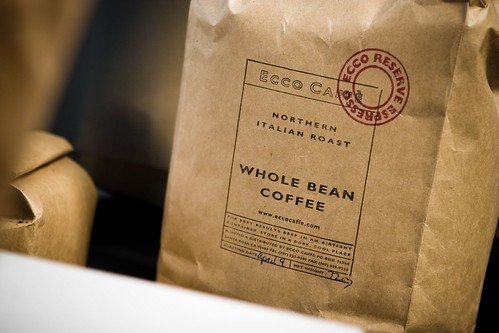
We entered early and set up our version of vac pots we had learned from Simon in Taiwan. We scoped some different coffees and settled on what looked like the best roast for the method. It was actually a coffee we were all very familiar with. Part Fazenda Cachoeira, part
 2004 Daterra Reserve, it was Andrew Barnett's Ecco Reserve. We were comfortable enough brewing this that it actually came out with a very crisp cup getting a subtle fruit tone to go with the caramel and nuts in the cup leaving a sweet lasting finish. We were grateful enough that Andrew sent coffees that I would call him later to thank him. Sometimes, the old familiar coffees are the ones you know how to work best. We brewed vac pots several times until my cohorts abandoned me and I could no longer continue.
2004 Daterra Reserve, it was Andrew Barnett's Ecco Reserve. We were comfortable enough brewing this that it actually came out with a very crisp cup getting a subtle fruit tone to go with the caramel and nuts in the cup leaving a sweet lasting finish. We were grateful enough that Andrew sent coffees that I would call him later to thank him. Sometimes, the old familiar coffees are the ones you know how to work best. We brewed vac pots several times until my cohorts abandoned me and I could no longer continue.Saturday 10:00am
 Once free to move around I slipped by the Espresso parts booth to chat about equipment and food. It was exciting to see Dave had trotted out the tamper mod with the brass ring we liked so much we were calling it the Barismo-Spec!
Once free to move around I slipped by the Espresso parts booth to chat about equipment and food. It was exciting to see Dave had trotted out the tamper mod with the brass ring we liked so much we were calling it the Barismo-Spec! 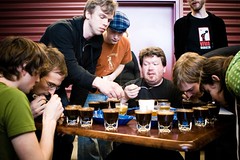 After browsing the crowd a bit and meeting some more awesome people, I joined Silas, Kaminsky, and Judson for a cupping upstairs. Keith from Victrola had brought a lineup of 5 Colombia CoE, a defect Colombia, and the Colombia Victrola was currently selling. We broke crust and smelled them all, the defect being obvious early on.
After browsing the crowd a bit and meeting some more awesome people, I joined Silas, Kaminsky, and Judson for a cupping upstairs. Keith from Victrola had brought a lineup of 5 Colombia CoE, a defect Colombia, and the Colombia Victrola was currently selling. We broke crust and smelled them all, the defect being obvious early on.  All of us immediately identified the CoE #1 and strangely began crowding around it when it was time to cup it. Filling in the rest was fun guessing but overall, it was a great setup from Victrola. Afterwards we talked a bit more then went for lunch with Gabe and Ashley.
All of us immediately identified the CoE #1 and strangely began crowding around it when it was time to cup it. Filling in the rest was fun guessing but overall, it was a great setup from Victrola. Afterwards we talked a bit more then went for lunch with Gabe and Ashley. 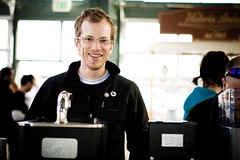 Zander of the Coffee Equipment Company joined us for lunch leaving a shocked Kaminsky who halfway thru the lunch finally realized he was sitting next to the 'the clover guy.' Of course Kaminsky immediately began asking the hard hitting questions. We headed out after saying goodbyes to everyone and headed towards seattle.
Zander of the Coffee Equipment Company joined us for lunch leaving a shocked Kaminsky who halfway thru the lunch finally realized he was sitting next to the 'the clover guy.' Of course Kaminsky immediately began asking the hard hitting questions. We headed out after saying goodbyes to everyone and headed towards seattle.Seattle Mon 9:59am
 We took Keith up on his invite to tour the roasterie and checked Victrola's new location out. It was polished and the barista's were skilled in what would be the most notable shot we had in Seattle. Shortly thereafter, we headed over for a quick lunch and dropped by Vivacce momentarily before we had to bolt across town to the airport to drop Judson off with minutes to spare to catch his flight.
We took Keith up on his invite to tour the roasterie and checked Victrola's new location out. It was polished and the barista's were skilled in what would be the most notable shot we had in Seattle. Shortly thereafter, we headed over for a quick lunch and dropped by Vivacce momentarily before we had to bolt across town to the airport to drop Judson off with minutes to spare to catch his flight.Monday 1:30pm
Zander invited us to visit and of course we had to take them up on their offer if not only for the shots of Hairbender they were pulling but also for some conversation and Clover swag. Zander was very generous in answering all our questions and listening to our opinions at length. We exchanged business philosophies talked about roasters and compared clover to other brew methods. It gave us more respect and a unique perspective of the Clover team. Zander recommended we visit lighthouse but time was short and we made our way up the streets to a little place called Floating Leaves. A tea house where we were aware they had a Dha yu ling tea. A major score for any dedication Taiwanese tea enthusiast. Crunched for time, we made a mad dash into town searching for an Amtrak station. Though we had no idea where it was, through Kaminsky's dedication to jump into traffic and ask directions/check maps, we were able to get Silas on the train without moments to spare.
Monday 8:57pm
Both the Clover and Espresso Parts crews recommended this bar to visit but we could not remember the name exactly. It started with a B. We spent Sunday night searching and searching unsuccessfully until we gave up. Kaminsky and I with two hours before flight decided the trip could not be a success unless we succeeded in finding this place. Circling and circling we turned into a side street where a large warehouse with a griffin painted on the side was. It occurred to us this might be the place. A sense of relief that we would have good eats and a place to relax came over us. Checking the tiny A frame outside, it was Brouwards. We piled in and
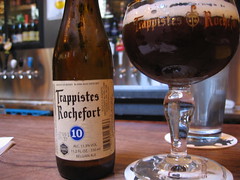 ordered a massive stack of pomme frites with an array of sauces and settled into what seemed like the biggest 'veggie' burgers we had ever had. By the end of the meal we discovered two things. We don't like beer so much as we love 'barley wine.' Seattle is great and the people were awesome, but Cambridge with all it's strange habits and unique charm is not too bad either.
ordered a massive stack of pomme frites with an array of sauces and settled into what seemed like the biggest 'veggie' burgers we had ever had. By the end of the meal we discovered two things. We don't like beer so much as we love 'barley wine.' Seattle is great and the people were awesome, but Cambridge with all it's strange habits and unique charm is not too bad either.


